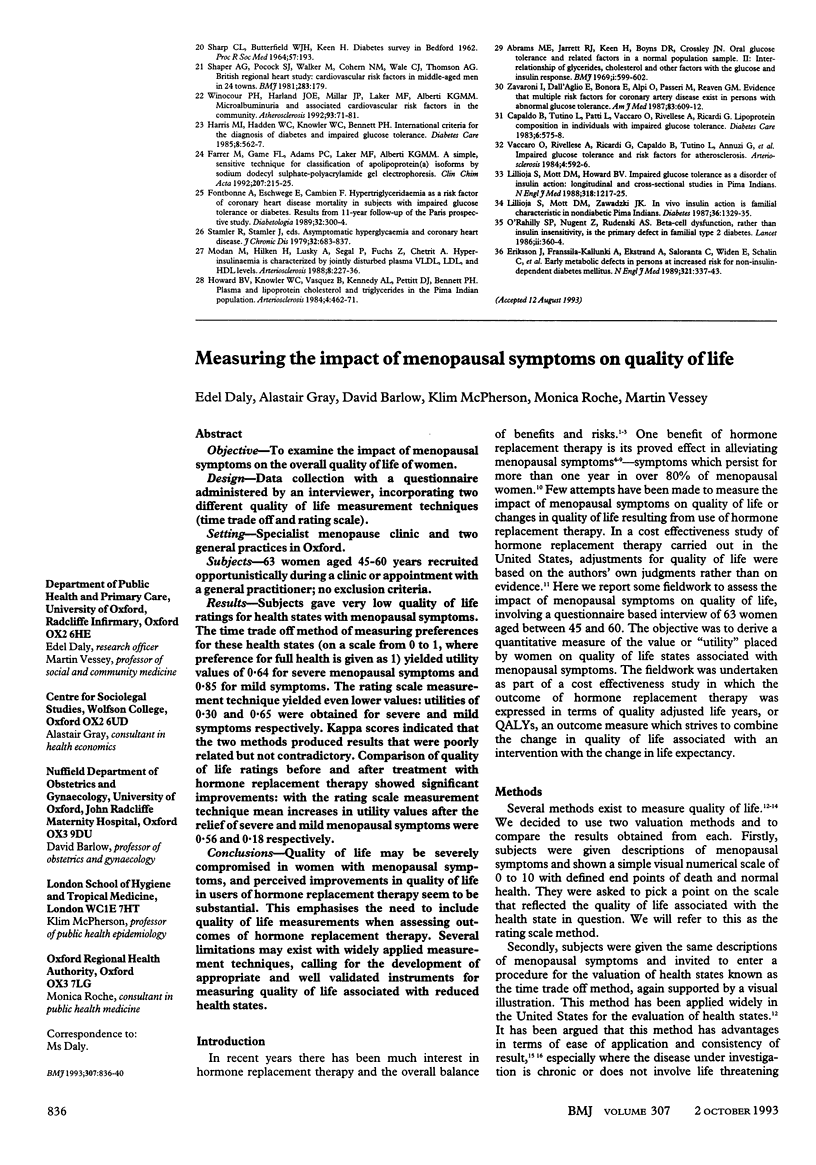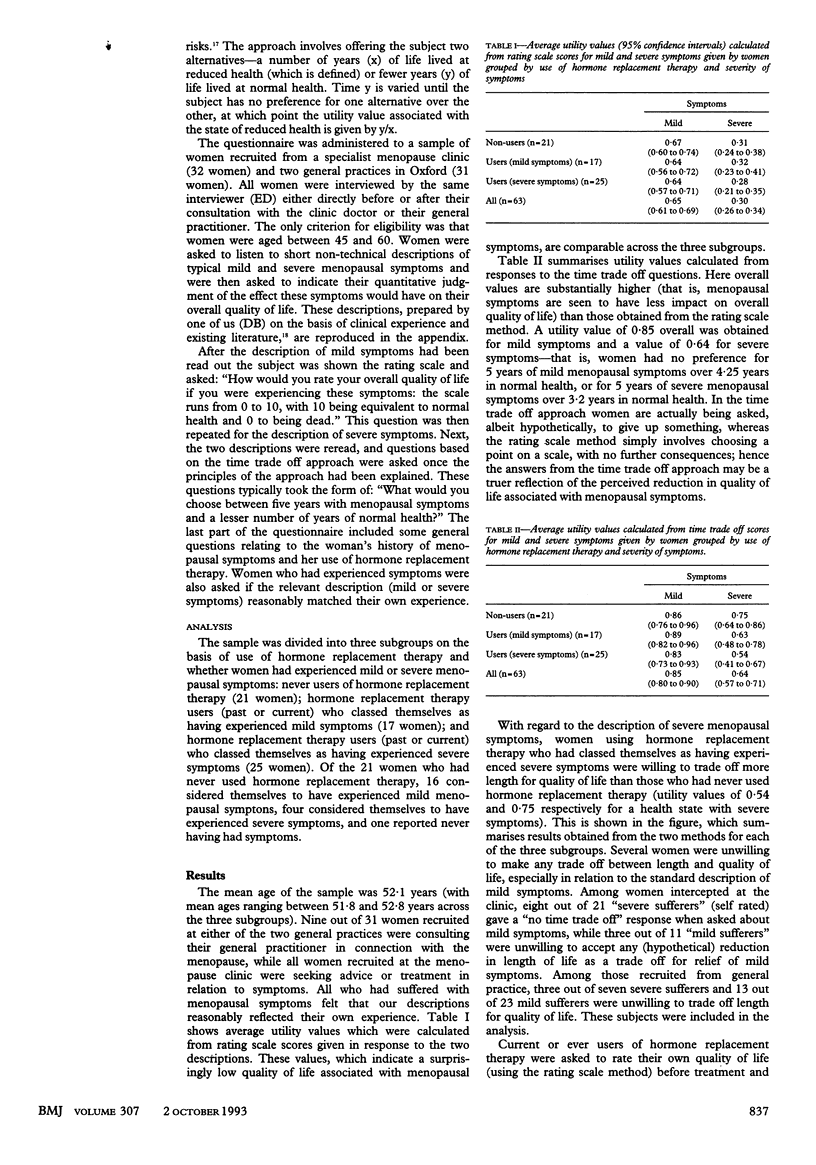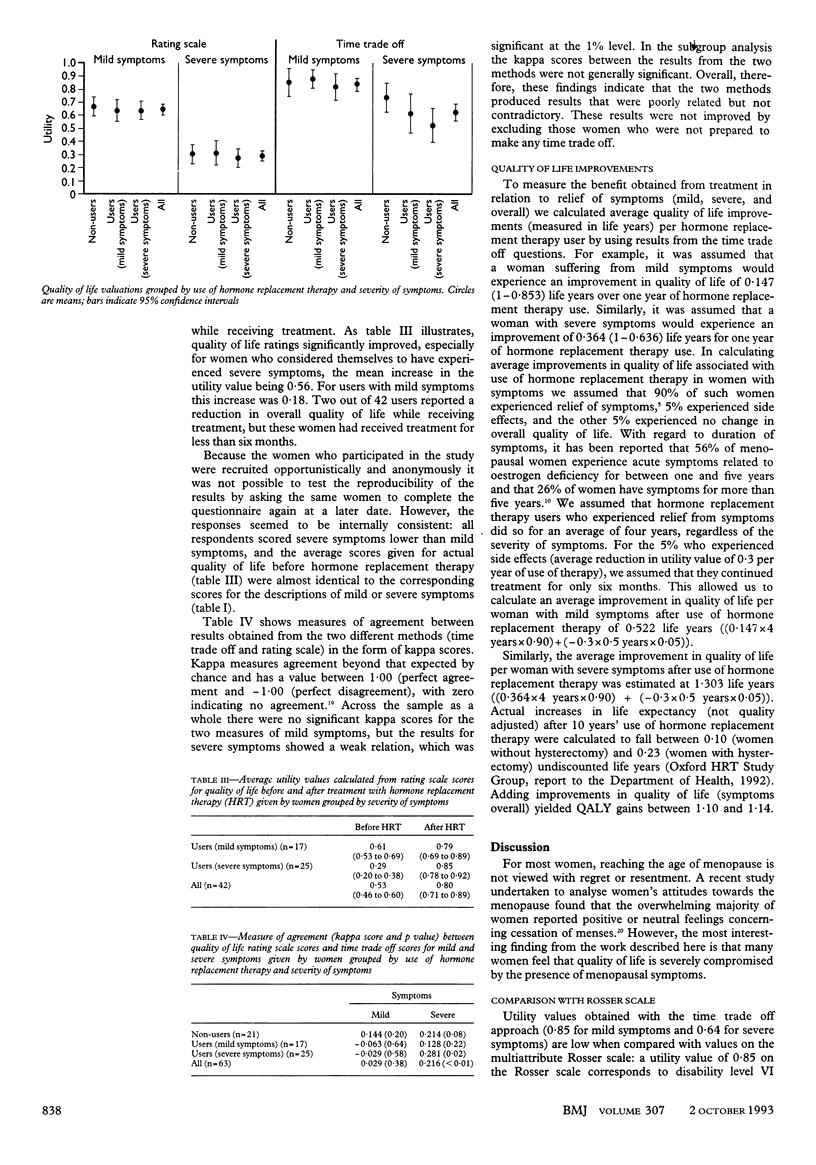Abstract
OBJECTIVE--To examine the impact of menopausal symptoms on the overall quality of life of women. DESIGN--Data collection with a questionnaire administered by an interviewer, incorporating two different quality of life measurement techniques (time trade off and rating scale). SETTING--Specialist menopause clinic and two general practices in Oxford. SUBJECTS--63 women aged 45-60 years recruited opportunistically during a clinic or appointment with a general practitioner; no exclusion criteria. RESULTS--Subjects gave very low quality of life ratings for health states with menopausal symptoms. The time trade off method of measuring preferences for these health states (on a scale from 0 to 1, where preference for full health is given as 1) yielded utility values of 0.64 for severe menopausal symptoms and 0.85 for mild symptoms. The rating scale measurement technique yielded even lower values: utilities of 0.30 and 0.65 were obtained for severe and mild symptoms respectively. Kappa scores indicated that the two methods produced results that were poorly related but not contradictory. Comparison of quality of life ratings before and after treatment with hormone replacement therapy showed significant improvements: with the rating scale measurement technique mean increases in utility values after the relief of severe and mild menopausal symptoms were 0.56 and 0.18 respectively. CONCLUSIONS--Quality of life may be severely compromised in women with menopausal symptoms, and perceived improvements in quality of life in users of hormone replacement therapy seem to be substantial. This emphasises the need to include quality of life measurements when assessing outcomes of hormone replacement therapy. Several limitations may exist with widely applied measurement techniques, calling for the development of appropriate and well validated instruments for measuring quality of life associated with reduced health states.
Full text
PDF




Selected References
These references are in PubMed. This may not be the complete list of references from this article.
- Avis N. E., McKinlay S. M. A longitudinal analysis of women's attitudes toward the menopause: results from the Massachusetts Women's Health Study. Maturitas. 1991 Mar;13(1):65–79. doi: 10.1016/0378-5122(91)90286-y. [DOI] [PubMed] [Google Scholar]
- Bryan S., Parkin D., Donaldson C. Chiropody and the QALY: a case study in assigning categories of disability and distress to patients. Health Policy. 1991 Jul;18(2):169–185. doi: 10.1016/0168-8510(91)90098-i. [DOI] [PubMed] [Google Scholar]
- Bungay G. T., Vessey M. P., McPherson C. K. Study of symptoms in middle life with special reference to the menopause. Br Med J. 1980 Jul 19;281(6234):181–183. doi: 10.1136/bmj.281.6234.181. [DOI] [PMC free article] [PubMed] [Google Scholar]
- Campbell S., Whitehead M. Oestrogen therapy and the menopausal syndrome. Clin Obstet Gynaecol. 1977 Apr;4(1):31–47. [PubMed] [Google Scholar]
- Coast J. Reprocessing data to form QALYs. BMJ. 1992 Jul 11;305(6845):87–90. doi: 10.1136/bmj.305.6845.87. [DOI] [PMC free article] [PubMed] [Google Scholar]
- Coope J., Thomson J. M., Poller L. Effects of "natural oestrogen" replacement therapy on menopausal symptoms and blood clotting. Br Med J. 1975 Oct 18;4(5989):139–143. doi: 10.1136/bmj.4.5989.139. [DOI] [PMC free article] [PubMed] [Google Scholar]
- Cubbon J. The principle of QALY maximisation as the basis for allocating health care resources. J Med Ethics. 1991 Dec;17(4):181–184. doi: 10.1136/jme.17.4.181. [DOI] [PMC free article] [PubMed] [Google Scholar]
- Daly E., Roche M., Barlow D., Gray A., McPherson K., Vessey M. HRT: an analysis of benefits, risks and costs. Br Med Bull. 1992 Apr;48(2):368–400. doi: 10.1093/oxfordjournals.bmb.a072552. [DOI] [PubMed] [Google Scholar]
- Ditkoff E. C., Crary W. G., Cristo M., Lobo R. A. Estrogen improves psychological function in asymptomatic postmenopausal women. Obstet Gynecol. 1991 Dec;78(6):991–995. [PubMed] [Google Scholar]
- Fitzpatrick R., Fletcher A., Gore S., Jones D., Spiegelhalter D., Cox D. Quality of life measures in health care. I: Applications and issues in assessment. BMJ. 1992 Oct 31;305(6861):1074–1077. doi: 10.1136/bmj.305.6861.1074. [DOI] [PMC free article] [PubMed] [Google Scholar]
- GREENBLATT R. B., BARFIELD W. E., GARNER J. F., CALK G. L., HARROD J. P., Jr Evaluation of an estrogen, androgen, estrogen-androgen combination, and a placebo in the treatment of the menopause. J Clin Endocrinol Metab. 1950 Dec;10(12):1547–1558. doi: 10.1210/jcem-10-12-1547. [DOI] [PubMed] [Google Scholar]
- Harris J. Unprincipled QALYs: a response to Cubbon. J Med Ethics. 1991 Dec;17(4):185–188. doi: 10.1136/jme.17.4.185. [DOI] [PMC free article] [PubMed] [Google Scholar]
- Hunt K. Perceived value of treatment among a group of long-term users of hormone replacement therapy. J R Coll Gen Pract. 1988 Sep;38(314):398–401. [PMC free article] [PubMed] [Google Scholar]
- Kanis J. A., Minne W. H., Meunier P. J., Ziegler R., Allender E. Quality of life and vertebral osteoporosis. Osteoporos Int. 1992 Jul;2(4):161–163. doi: 10.1007/BF01623919. [DOI] [PubMed] [Google Scholar]
- McKinlay S. M., Jefferys M. The menopausal syndrome. Br J Prev Soc Med. 1974 May;28(2):108–115. doi: 10.1136/jech.28.2.108. [DOI] [PMC free article] [PubMed] [Google Scholar]
- McTurk L. A methodological quibble about QALYs. BMJ. 1991 Jun 29;302(6792):1601–1601. doi: 10.1136/bmj.302.6792.1601-b. [DOI] [PMC free article] [PubMed] [Google Scholar]
- Roberts P. J. The menopause and hormone replacement therapy: views of women in general practice receiving hormone replacement therapy. Br J Gen Pract. 1991 Oct;41(351):421–424. [PMC free article] [PubMed] [Google Scholar]
- Rosser R., Kind P. A scale of valuations of states of illness: is there a social consensus? Int J Epidemiol. 1978 Dec;7(4):347–358. doi: 10.1093/ije/7.4.347. [DOI] [PubMed] [Google Scholar]
- Sackett D. L., Torrance G. W. The utility of different health states as perceived by the general public. J Chronic Dis. 1978;31(11):697–704. doi: 10.1016/0021-9681(78)90072-3. [DOI] [PubMed] [Google Scholar]
- Spiegelhalter D. J., Gore S. M., Fitzpatrick R., Fletcher A. E., Jones D. R., Cox D. R. Quality of life measures in health care. III: Resource allocation. BMJ. 1992 Nov 14;305(6863):1205–1209. doi: 10.1136/bmj.305.6863.1205. [DOI] [PMC free article] [PubMed] [Google Scholar]
- Thomson J., Oswald I. Effect of oestrogen on the sleep, mood, and anxiety of menopausal women. Br Med J. 1977 Nov 19;2(6098):1317–1319. doi: 10.1136/bmj.2.6098.1317. [DOI] [PMC free article] [PubMed] [Google Scholar]
- Torrance G. W. Measurement of health state utilities for economic appraisal. J Health Econ. 1986 Mar;5(1):1–30. doi: 10.1016/0167-6296(86)90020-2. [DOI] [PubMed] [Google Scholar]
- Weinstein M. C., Schiff I. Cost-effectiveness of hormone replacement therapy in the menopause. Obstet Gynecol Surv. 1983 Aug;38(8):445–455. doi: 10.1097/00006254-198308000-00001. [DOI] [PubMed] [Google Scholar]
- Wilkes H. C., Meade T. W. Hormone replacement therapy in general practice: a survey of doctors in the MRC's general practice research framework. BMJ. 1991 Jun 1;302(6788):1317–1320. doi: 10.1136/bmj.302.6788.1317. [DOI] [PMC free article] [PubMed] [Google Scholar]
- Wren B. G., Brown L. Compliance with hormonal replacement therapy. Maturitas. 1991 Mar;13(1):17–21. doi: 10.1016/0378-5122(91)90281-t. [DOI] [PubMed] [Google Scholar]


